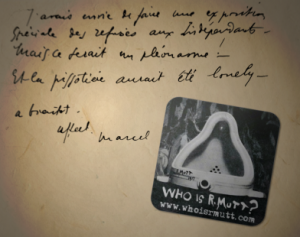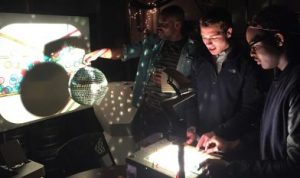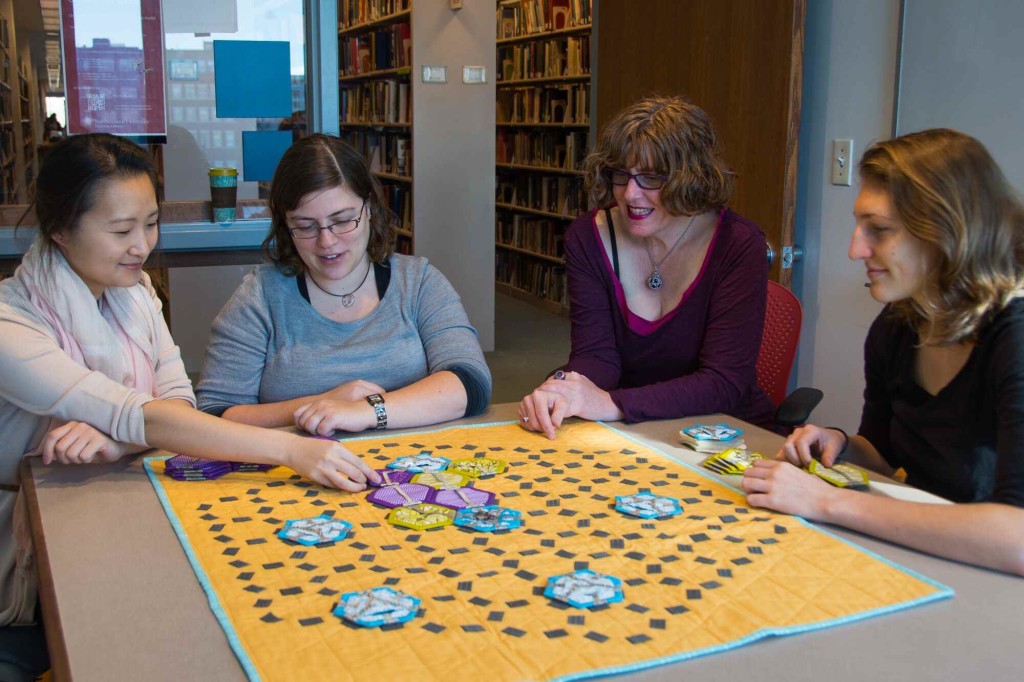
Celia and her team work on their game “eBee”
Dr. Celia Pearce is a game designer, author, researcher, teacher, curator and artist, specializing in multiplayer gaming and virtual worlds, independent, art, and alternative game genres, as well as games and gender. She is also Associate Professor of Game Design here at Northeastern, as well as co-founder of IndieCade, and was recently accepted into a summer residency at Blast Theory. Celia has been a huge admirer of Blast Theory, an audience-focused artist group creating interactive art to explore social and political questions, for years, even before her interest in the residency. We sat down with Celia to ask her about her plans for the upcoming residency and her current projects.

As your residency with Blast Theory approaches, what are you looking forward to?
There are three projects that I put into proposal that earned me the residency. The first one is a game that I have been working on with students here at Northeastern called Who Is R. Mutt? It is a feminist art history game and is also what is called an Alternate Reality (AR) game. That is a game that bleeds between reality and the game world. Because it’s a documentary about real-world events, it’s integrated into the real world so the game drives people back into the real world, onto the internet, into libraries and museums, etc.
How long have you been working on the project?
I have been working on this for the last two years with a team of Northeastern students. It is a really complicated project because there are a lot of moving parts.
AR games usually have multiple software platforms; they are often called “transmedia” because of this. So there is a web component, an augmented reality mobile application, and there will also be events and performances woven into the game experience. Blast Theory is known for creating these types of performative, theatrical, pervasive events. I need some feedback and help on building something this complex, on creating a story across many different kinds of media, and how to integrate that story in physical locations.
Also, there is the practical question of how to get it funded. A lot of the students have been work-studies, volunteers, and directed studies. They aren’t doing this full time and have a lot of other priorities. What I would really like to do is get some funding to get the game into full production. I want to hire those students with paid positions and bring on some local indie developers as consultants, especially one or two who current teach here as adjuncts.
How did you come up with the idea for this project?
The project is really integrated into my experience at Northeastern and is inspired by one of my classes. I teach this class called Experimental Game Design, which uses 20th century Avant-garde art movements to teach about game design. Many of these movements specifically used games and play as a part of their repertoire. It’s not taught a lot to Games students, but because we are in a College that also houses Arts programs and my students are getting a BFA in Game Design, I wanted them to understand how the fine arts integrate into games.
Two years ago, I was visiting a friend in Los Angeles who teaches at USC, and he told me that he was actually doing the homework assignments that he assigned to his students. Inspired by this, I started doing my own assignments! At the same time, I was doing research for one of the lectures on the Dada movement, which was international, included many women, used a play methodologies, and invented appropriation techniques such as collage. As I was doing this research, I stumbled upon this really interesting finding about a piece of art, attributed to Marcel Duchamp, called “Fountain,” which is a urinal tipped on its side with the words “R. Mutt” written on it. “Fountain” is considered by many to be the most important artwork of the 20th century, and has been called the first piece of conceptual art. While researching for this lecture, I discovered that there was evidence that he didn’t make the work at all, and that it was made by a woman. So, I started digging and it really was a rabbit hole. As I was doing this research, I realized, “Oh, this is an AR game already! But a real alternate reality – a different version of history.” It’s very easy for us to assume that history is a static thing but what people don’t see is that there are different versions. So while using the Dada tactic of appropriation, I began to design this game-and it all began from doing my own homework assignment and conducting research from my class.
This game is most integrated with my teaching and research. It speaks to how, as a scholar, my teaching, creativity, art, and research all support each other. I think if I was just a researcher without teaching, or an artist without a research focus, I wouldn’t have done this.
A letter from the game “Who is R. Mutt?”How has it been getting students involved in the project?
I am very inspired by my students. This game is tailor made for Millennials because it really addresses issues of identity and representation. The kids that joined the team have made this a cause beyond just a game. The process is very collaborative—they have done the bulk of the research and creative work with my creative direction. I push them and they push me. I was just looking at the work they did last week and it was funny because the group I was working with had all been in the class and I had this revelation-they learned how to do this work in the class and then they took it further and brought their own ideas, sensibilities, and aesthetics to it. They learned how to do collage in my class and then they created this collage game engine that has you move around the pieces to solve a puzzle. So through collaborating with them, I am also seeing and reinforcing the creative application of what they learned in the class. It’s very much “experiential learning” in that respect.
In Who is R. Mutt? there is a performative aspect. Does the game exist on a schedule?
I’m not planning to run the game on a fixed schedule, but we have designed a few performative events for specific festivals, as well as location-based quests. There are large parts of the story that take place in New York, for instance, so we have designed minigames and performances designed to be run in conjunction with festivals there. We are also trying to get players to do actions, actually a protest acts – a very lightweight ones, but it is a way to get players engaged if they really want to pursue this and get people to pay attention to the issue.

Has your discovery of the history of “Fountain” affected the game?
As the story has evolved, we found there’s a few different women who were implicated in the story, so we crafted the experience as a mystery game that starts with a group of “suspects.” Involvement of women in the Dada movement tends to be downplayed, even though it was very critical. There are also mechanisms that worsen that. For instance, one of the women has 3 different names because she was married twice, so you look up each name and get three different stories, and we’ve only found only one photo of her at that time, even though we have dozens of images of Duchamp.
What is the second project that you are bringing?
The second project is called Analog Holodeck. I’ve gotten really interested in immersive theatre. It’s a growing area and there’s a lot of it going on in the Northeast and NY. The last couple of years, I have been doing a lot of live action role-playing (LARP), which is a genre of physical games that are typically not technological, involving characters and stories, like an improvised play with no audience. The players are the actors.
How did you get the idea for this project?
I have been LARPing and going to New York twice to see Sleep No More, an immersive theatre piece based on MacBeth, and I’ve been playing a lot of escape rooms. Sleep No More has a physical set that you can explore, with actors running around doing different things. As a game designer and gamer, I started playing it like a game: I was opening drawers and reading notes… and about 20 minutes into it, I realized “oh, this is a play, there are actors, that’s what plays are about.” So I started following the actors, but I ended up following different tracks from the rest of the audience. There are a lot of audio cues throughout the piece and everyone would run towards the sound of yelling for instance, while I would see an actor sneaking through a door behind me, and I would follow him, going the opposite direction of everyone else. I really enjoyed aspects of Sleep No More, but I was disappointed that the stagecraft was underutilized.

I also realized that my friend and I had completely different experiences in the show, which was great. For example, she noted that there was tons of nudity and I didn’t see any at all. There were whole rooms that each of us had been in that the other had not seen, and rooms that we saw at different points in the story. It is an amazing act of theatricality, like a theme park and a play combined. But on the other hand I’m doing all this LARPing and escape rooms and I really wish these immersive theatre pieces gave me the same sense of agency and interaction. In a LARP, I create my own character that I part of the story.
Anyway, I discovered people in Boston working on the same problem-game designers producing immersive theatrical events who are trying to work out add more agency agency. So I am creating a collaborative community to work on this problem. I partnered with theatre faculty member Dani Snyder-Young on this, who is the co-PI. She knows so much about activist theatre and participatory techniques at a very high level. I love interdisciplinary groups because. We will talk about stuff and I realize we are using the same word to mean something different, or they will realize that we are using a different term for the same thing. We are trying to develop a shared vocabulary and learn from each other to make this kind of work better. I think societally we are at a point where participatory culture is so pervasive, but live performance has yet to fully catch up.
Have they had problems in Sleep No More because of the anonymous quality of their audience?
They have had a lot of problems, and they are very similar to the harassment issues people have in online games. The second time I went to see Sleep No More, I observed an interesting interaction in a candy store set. I discovered audience members who were stealing candy from the jars in the store. But that’s all it was – taking candy, and for no reason, with no consequence. If I designed that show I would want the candy to do something. If people take an action, there should be a consequence.
Do people think more about consequences if they are not anonymous?
I’ve done a lot of research into online games, and I think anonymity is misunderstood. One of the great things about online worlds is that you can create who you want to be. However, this also allows for freedom to grief and harass other players with little or no consequences. How do we find a way to balance between creative expression and mitigating that negative behavior? This is something I’ve been studying for many years.
For me, Blast Theory is pervasive game/performance bootcamp. I will be there for two months, around people at the top of their form, to absorb everything about how they work. I am also looking forward to having time to do my own work outside of teaching and academia. I am thinking about it as a retreat to go and workshop my projects and bring them back stronger. I only wish I could take the student team with me because they are so much a part of my creative process. I feed off of their ideas and aesthetics!
Figuring out how to effectively work with an audience member must be difficult, how do you approach it on a larger scale?
That’s something that Blast Theory does really well! They created this piece called Uncle Roy is All Around You in the late 1990s, where you are given an invitation to go to an address and there is an actor there, performing to you. This single audience member approach is hard to sustain, but they’ve since developed many techniques for expanding the audience. I used to work in the theme park industry, where they are very aware of “throughput”—how many audience members can you move through a ride. That’s one of these things I was amazed by with Sleep No More… they can get so many people through that thing.
But what I would like to see is something a little more interactive, more creative. I want the audience to co-create the experience with you, which is what LARPs do. Sometimes they are very cumbersome. I once had to read a 60-page dossier about my character before playing a LARP. I had to remember who I needed to talk to, my characters family and friends, which is way too much overhead to ask of a participant. How I am supposed to remember all of that? On the other hand, I have been in LARPs where I was given a one sentence prompt and had a fantastic experience.
What is your final project?
The third one comes out of my work with Indiecade. I am currently writing a book surrounding our 10 year anniversary. We launched the festival in 2008, and as I started working on the book, I realized that there is a complex indie game ecosystem, but really don’t know much about how it works. You have festivals, and game jams, and self-publishing platforms, and iOS and Kickstarter and University programs like ours. So as I am writing this book to figure draw a bigger picture, to figure out all the different aspects of this complex ecosystem. I want to try and map out what this looks like.

How long is your residency at Blast Theory?
The residency is around two months long, and they have an apartment in the studio so I’ll be living there. It’s in Brighton Beach which is like the Coney Island of England. It is an hour and half train ride to London and I want to take field trips to see some European LARPs. I’ll also be attending a conference in Sheffield which is intersecting with a Dialogue of Civilizations lead by CAMD faculty member David Tames, where I’ll be doing a workshop with his students.
How are you preparing these three projects to bring them to Blast Theory?
We made a proof of concept prototype for the R. Mutt. For the Analog Holodeck, because it’s early in the project, we can see to what extent Blast Theory wants to be involved, and I also plan to see related work in the UK, which is where Sleep No More originated before its American debut in Boston. I also plan to interview them and have a look at their archives.
One of my main interests in going there is to study Blast Theory’s process of how they make work, how they prototype and test out ideas. In the game world we do a lot of playtesting, so I want to know how they work, their goals, how they ideate, how they iterate. I want to understand how they build their relationship with participants, how they craft audience engagement, etc. It’s a hard thing to do and they have the interaction aesthetic. People who make this kind of work have a particular style of interaction and I’d like to learn how they draw that out of people, so that will be a major part of what I hope to get out of spending the summer with them.
See more of Celia’s work here!


